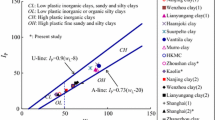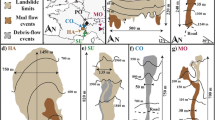Abstract
As a result of the scarcity of land for construction, a number of projects to construct man-made islands or to expand lands over soft grounds keeps increasing. Creep behaviour of soft ground has been considered as a challenging issue for engineers and researchers for many years. A number of studies have focused on the method to predict the creep deformation of the ground under a construction site. However, there is no unified theory to clearly explain the mechanism of soil creep deformation of soils. Results of the critical review in this paper indicate that the causes of soil creep can be categorised into five main groups, namely (a) the breakdown of the inter-particle bonds, (b) sliding between the soil particles, (c) water flow from micro-pores to macro-pores (d) the deformation due to the structural viscosity and (e) the deformation due to the jumping of bonds. This paper presents these mechanisms in details with an effort to recommend an enhanced explanation for the creep compression mechanisms of clays.









Similar content being viewed by others
References
Akagi H (1994) A physico-chemical approach to the consolidation mechanism of soft clays. Soils Found 34(4):43–50
Ameratunga J, De Bok C, Boyle P, Berthier D (2010) Ground improvement in Port of Brisbane (PoB) clay. ISSMGE Bull 4(2):28–54
Barden L (1969) Time dependent deformation of normally consolidated clays and peats. J Soil Mech Found Div 95:1–31
Berry PL, Poskitt TJ (1972) The consolidation of peat. Geotechnique 22(1):27–52
Bjerrum L (1967) Engineering geology of Norwegian normally-consolidated marine clays as related to settlements of buildings. Geotechnique 17:81–118
Bolt GH (1956) Physico-chemical analysis of the compressibility of pure clays. Geotechnique 6(2):86–93
Bouazza A, Kwan PS, Chapman G (2004) Strength properties of cement treated Coode Island Silt by the soil mixing method. In: Proceedings of GeoTrans, geotechnical engineering for transportation projects (GSP 126), pp 1421–1428
Christensen RW, Wu TH (1964) Analysis of clay deformation as a rate process. J Soil Mech Found 90:125–157
Christie IF, Tonks DM (1985) Developments in the time line theory of consolidation. In: The 11th international conference on soil mechanics and foundation Engineering, San Francisco, pp 423–426
Craig P (2004) Craig’s soil mechanics, 7th edn. Taylor & Francis, New York
Crooks JHA, Becker DE, Jerreries MG, McKenzie K (1984) Yield behaviour and consolidation. I: pore water response. In: Yong RN, Townsend FC (eds) Proceedings, Symposium on sedimentation consolidation models: prediction and validation. San Francisco, ASCE, pp 356–381
Das BM (2008) Advanced soil mechanics, 3rd edn. Taylor & Francis, New York
De Jong GJ, Verruijt A (1965) Primary and secondary consolidation of a spherical clay sample. In: Proceeding of the 6th international conference soil mechanic and foundation engineering, Montreal, pp 254–258
Ervin M (1992) Engineering properties of Quatemary age sediments of the Yarra delta. In: Peck WA, Neilson JL, Olds RJ, Seddon KD (eds) Engineering geology of Melbourne. AA Balkema, Rotterdam, pp 245–259
Feda J (1992) Creep of soils and related phenomena, Elsevier
Fredlund DG, Rahardjo H (1993) Soil mechanics for unsaturated soils. Wiley, New York
Garlanger JE (1972) The consolidation of soils exhibiting creep under constant effective stress. Geotechnique 22(1):71–78
Gibson RE, Lo KY (1961) A theory of consolidation exhibiting secondary compression. In: Norwegian Geotechnical Institute
Graham J, Yin JH (2001) On the time-dependent stress-strain behaviour of soft soils. Paper presented at the Soft Soil Engineering
Graham J, Tanaka N, Crilly T, Alfaro M (2001) Modified cam-clay modelling of temperature effects in clays. Can Geotech J 38:608–621
Grim RE (1962) Applied clay mineralogy, International series in the earth and planetary sciences. McGrawHill, New York
Grim RE (1968) Clay mineralogy. International series in the earth and planetary sciences, 2nd edn. Mcgraw Hill, New York
Gupta B (1964) Creep of saturated soil at different temperatures. PhD Thesis, The University of British Columbia, Canada
Guven N (1993) Molecular aspects of clay-water interactions. In: Guven N, Pallastro RM (eds) Clay water interface and its rheological properties,CMS workshop lectures. Clay Minerals Society, pp 2–79
Huang W, Fityus S, Bishop D, Smith D, Sheng D (2006) Finite element parametric study of the consolidation behaviour of a trial embankment on soft clay. Int J Geomech 6(5):328–341
Indraratna B (2010) Recent advances in the application of vertical drains and vacuum loading in soft soil stabilisation. 2009 EH David Memorial Lecture, Australian Geomechanics Society, 45(2):1–43
Kuhn MR, Mitchell JK (1993) New perspectives on soil creep. J Geotech Eng 119(3):507–524
Kwok CY, Bolton MD (2010) DEM simulations of thermally activated creep in soils. Geotechnique 60(6):425–433
Leonards GA, Girault PA (1961) Study of one dimensional consolidation tests. In: Proceeding of 5th international conference soil mechanics, Paris, pp 213–218
Leroueil S, Kabbaj M, Tavenas F, Bouchard R (1985) Stress-strain-strain rate relation for the compressibility of sensitive natural clays. Geotechnique 35(2):159–180
Low PF (1962) Influence of adsorbed water on exchangable ion movement. Paper presented at the proceedings of the 9th national conference on clays and clay minerals, New York
Matsuo S, Kamon M (1977) Macroscopic study on deformation and strength on clays. In: Proceedings of the 9th international conference on soil mechanics and foundation engineering, Tokyo, Japan, pp 201–204
Mcllquham J (2010) Geotechnical design of transition structures for the Port Botany Expansion. ISSMGE Bull 4(2):55–62
Mesri G (1973) Coefficient of secondary compression. J Soil Mech Found Div, ASCE 99(1):123–137
Mesri G (2003) Primary compression and secondary compression In: Soil behaviour and soft ground construction, vol 119. Geotechnical special publication, ASCE, Reston, pp 122–166
Mesri G, Godlewski PM (1977) Time and stress compressibility interrelationship. J Geotech Eng 103(5):417–430
Mesri G, Olson RE (1971) Mechanisms controlling the permeability of clays. Clays Clay Miner 19:151–158
Mitchell JK (1956) The fabric of natural clays and its relation to engineering properties. Highw Res Board Proc 35:693–713
Mitchell JK (1964) Shearing resistance of soils as a rate process. J Soil Mech Found Div ASCE 90(SM1):29–61
Mitchell JK (1976) Fundamentals of soil behaviour. Wiley, New York
Mitchell JK, Soga K (2005) Fundamentals of soil behaviour, 3rd edn. Wiley, New York
Mitchell JK, Campanella RG, Singh A (1968) Soil creep as a rate process. ASCE J SMFD 94(1):1–26
Murayama S, Shibata T (1961) Rheological properties of clays. In: Proceedings of the 5th international conference soil mechanics, Paris 1:269–273
Navarro V, Alonso EE (2001) Secondary compression of clay as a local dehydration process. Geotechnique 51(10):859–869
Ranjan G, Rao ASR (2007) Basic and applied soil mechanics. New Age International Publishers, New Delhi
Rao SN, Matthew PK (1995) Effects of exchangeable cations on hydraulic conductivity of a marine clay. Clays Clays Miner 43(4):433–437
Reeves G, Sims I, Cripps J (2006) Clay materials used in construction, The Geological Society
Singh A, Mitchell JK (1968) General stress-strain-time function for soils. J Soil Mech Found Div ASCE 94(SM3):709–734
Sridharan A (2001) Engineering behaviour of clays: influence of mineralogy. In: Chemo-mechanical coupling in clays: from nano-scale to engineering applications, Swets & Zeitlinger, Maratea
Sridharan A, Rao GV (1973) Mechanisms controlling volume change of saturated clays and the role of effective stress concept. Geotechnique 23(3):359–382
Sridharan A, Rao GV (1979) Shear strength behaviour of saturated clays and the role of effective stress concept. Geotechnique 29(2):177–193
Taylor DW (1942) Research on consolidation of clays. Department of Civil and Sanitation Engineering, Massachusetts Insitute of Technology, Report 82
Taylor DW, Merchant WA (1940) A theory of clay consolidation accounting for secondary compression. J Math Phys 19:167–185
Terzaghi K (1941) Undisturbed clay samples and undisturbed clays. J Boston Soc Civil Eng 29(3):211–231
Vermeer PA, Neher HP (2000) A soft soil model that accounts for creep. In: Beyond 2000 in Computational Geotechnics-10 years of PLAXIS International, Balkema, Rotterdam, 1999
Wang YH, Xu D (2006) Dual porosity and secondary consolidation. J Geotech Geoenviron Eng 133(7):793–801
Winkerkorn HW (1943) The condition of water in porous systems. Soil Sci 55(2):109–115
Wong PK (2006) Preload design, Part 1: review of soil compressibility behaviour in relation to the design of preloads, Australian Geomechanics Society Sydney chapter 2006 symposium, pp 27–32
Yin JH (1999) Non-linear creep of soils in oedometer tests. Geotechnique 49(5):699–707
Yin JH (2002) Calculation of settlements of foundation soils considering creep. In: Proceedings of the Nakase Memorial symposium on soft ground engineering in coastal areas, Yokosuka, Japan, pp 205–211
Yin JH, Graham J (1989) Viscous-elastic-plastic modelling of one dimensional time-dependent behaviour of clays. Can Geotech J 26:199–209
Yin JH, Graham J (1999) Elastic viscoplastic modelling of the time-dependent stress-strain behaviour of soils. Can Geotech J 36(4):736–745
Yin JH, Zhu JG, Graham J (2002) A new elastic viscoplastic model for time-dependent behaviour of normally and overconsolidated clays: theory and verification. Can Geotech J 39(1):157–173
Yong RN, Pusch R, Nakano M (2010) Containment of high level radioactive and hazardous solid wastes with clay barriers. Taylor & Francis, New York
Zeevaart L (1986) Consolidation in the intergranular viscosity of highly compressible soils. In: ASTM (ed) Consolidation of soils: testing and evaluation, vol 892. ASTM Special Technical Publication, Philadelphia, pp 257–281
Author information
Authors and Affiliations
Corresponding author
Rights and permissions
About this article
Cite this article
Le, T.M., Fatahi, B. & Khabbaz, H. Viscous Behaviour of Soft Clay and Inducing Factors. Geotech Geol Eng 30, 1069–1083 (2012). https://doi.org/10.1007/s10706-012-9535-0
Received:
Accepted:
Published:
Issue Date:
DOI: https://doi.org/10.1007/s10706-012-9535-0




